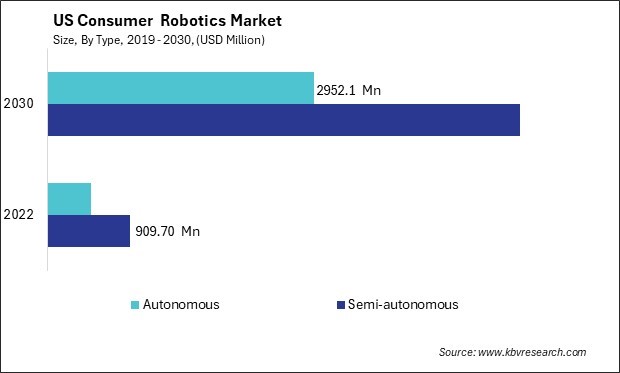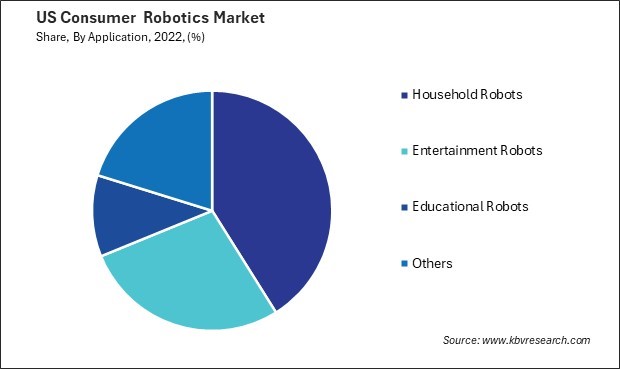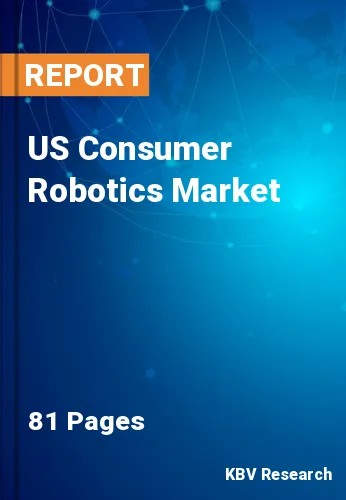The United States (US) Consumer Robotics Market size is expected to reach $8.2 Billion by 2030, rising at a market growth of 25.1% CAGR during the forecast period.
The consumer robotics market in the United States has witnessed remarkable growth in recent years, driven by technological advancements, increasing disposable income, and changing consumer preferences. One significant segment of the consumer robotics market is home robotics. Household robots, such as robotic vacuum cleaners, lawn mowers, and pool cleaners, have gained widespread acceptance among U.S. consumers seeking to automate mundane tasks and enhance their quality of life.

Another burgeoning sector within the consumer robotics market is personal assistant robots. These robots are designed to provide companionship, assistance, and entertainment to individuals, particularly the elderly and those with disabilities. Furthermore, the entertainment and educational robotics segment is experiencing rapid expansion in the U.S., driven by the rising popularity of STEM education and the increasing demand for interactive and immersive experiences. Educational robots, such as programmable kits and robotic toys, serve as valuable tools for teaching children coding, engineering, and problem-solving skills in a fun and engaging manner.
Moreover, the COVID-19 pandemic has accelerated the adoption of consumer robotics, with a growing emphasis on contactless solutions and remote operations. In response to social distancing measures and hygiene concerns, robots have been deployed in various settings, including retail stores, restaurants, and healthcare facilities, to minimize human-to-human contact and mitigate the risk of virus transmission. For instance, delivery robots have been utilized for contactless food and parcel delivery, while disinfection robots equipped with ultraviolet (UV) light have been deployed for sanitization purposes in public spaces.
The consumer robotics market in the United States has witnessed a significant surge in adopting robot assistance in recent years, driven by technological advancements, shifting consumer preferences, and the increasing integration of robotics into everyday life. One of the primary factors contributing to the rising adoption of robot assistance is the growing emphasis on convenience and efficiency. Americans are increasingly seeking solutions that automate mundane tasks, streamline processes, and enhance productivity in their daily lives. As a result, robots designed to assist with household chores such as cleaning, cooking, and organizing have gained popularity among busy households.
Furthermore, advancements in artificial intelligence (AI) and machine learning in the U.S. have enabled robots to become more intelligent and adaptive, capable of learning from user interactions and performing tasks with greater precision and autonomy. This evolution in robot capabilities has expanded their utility beyond simple repetitive tasks to more complex functions, such as personal assistance, entertainment, and companionship.
In the healthcare sector, robot assistance is revolutionizing patient care and medical procedures. Robots equipped with sensors and AI algorithms monitors vital signs, assist in surgeries, and provide rehabilitation therapy, enhancing healthcare delivery efficiency and improving patient outcomes. Integrating robot assistance in the U.S. is rapidly gaining traction, offering solutions that enhance efficiency, improve patient care, and alleviate burdens on healthcare professionals.
According to the United States Census Bureau, the healthcare and social assistance sector invested $704 million in 2021, an increase of $191 million (37.2%) from the 2020 total of $513 million. As technology advances and society embraces automation in various sectors, the rising adoption of robot assistance in healthcare exemplifies a transformative shift towards more sophisticated and interconnected healthcare ecosystems. Thus, adopting robot assistance in the United States reflects a growing demand for convenience, efficiency, and improved quality of life across various sectors, from household chores to healthcare.
The consumer robotics market in the United States is experiencing a remarkable surge in the popularity of autonomous robots. These robots, equipped with advanced sensors, artificial intelligence algorithms, and sophisticated navigation systems, are revolutionizing daily life for U.S. consumers. Advancements in technology have led to the development of cost-effective components, making it feasible for manufacturers to produce consumer-friendly robots at more reasonable price points. As a result, Americans are now more inclined to invest in these robots to simplify tasks and enhance convenience in their homes.
The versatility of autonomous robots is also contributing to their increasing popularity. From entertainment and companionship to education and healthcare assistance, these robots cater to various consumer needs and preferences. Whether it's a robot companion for children or elderly individuals, a robotic chef for meal preparation, or a personal assistant for managing schedules and reminders, there is a growing demand for these innovative solutions.
Another key driver is the growing demand for automation and smart home solutions. With busy lifestyles becoming the norm, American consumers seek ways to streamline household chores and routine tasks. Autonomous robots offer a compelling solution by taking on responsibilities such as vacuuming, mopping, lawn mowing, and even surveillance, freeing up time and energy for individuals to focus on other priorities. Therefore, the surge in popularity of autonomous robots in the United States is driven by advancements in technology, affordability, and their ability to cater to a wide range of consumer needs, ultimately offering convenience and efficiency in various aspects of daily life.

The consumer robotics market has seen significant growth and innovation in the United States. One prominent player in the U.S. consumer robotics market is iRobot Corporation. Founded in 1990, iRobot gained widespread recognition with its Roomba line of robotic vacuum cleaners. The Roomba has become a staple in households nationwide, offering convenient and efficient cleaning solutions. Over the years, iRobot has expanded its product range to include robotic devices such as the Braava, a robotic mop, and the Terra, a robotic lawn mower. With a focus on innovation and user experience, iRobot continues to lead the way in the consumer robotics space.
Another notable company in consumer robotics market is Anki, known for its interactive and educational robots. Anki's products, such as Cozmo and Vector, are designed to entertain and educate users through AI-powered interactions. Cozmo, in particular, has garnered praise for its expressive personality and ability to engage users of all ages in games and activities. Anki's approach to blending robotics with entertainment has earned it a dedicated following in the U.S. and beyond.
In the field of personal robotics assistants, Temi stands out as a leading provider. Temi's robot has advanced AI technology and features such as voice recognition, video calling, and autonomous navigation. Designed to assist users with tasks and provide entertainment, Temi offers a glimpse into the future of home automation and companion robotics. Its sleek design and intuitive interface make it a compelling choice for consumers seeking a versatile robotic companion.
In entertainment robotics, Boston Dynamics has made significant strides with its lifelike robots, such as Spot and Atlas. While primarily targeted at commercial and industrial applications, these robots have also captured the imagination of consumers with their impressive capabilities and agility. Boston Dynamics' innovative approach to robotics engineering has positioned it as a key player in shaping the future of human-robot interaction.
Additionally, startups like Misty Robotics are pushing the boundaries of what consumer robots can do. Misty Robotics' platform enables developers to create custom robotic solutions for various applications, from home automation to elder care. By empowering developers to unleash their creativity, Misty Robotics is fostering a vibrant ecosystem of robotic innovation in the U.S. With continued advancements in AI, mobility, and human-robot interaction, the future looks bright for consumer robotics in the U.S.
By Type
By Application
Our team of dedicated experts can provide you with attractive expansion opportunities for your business.

